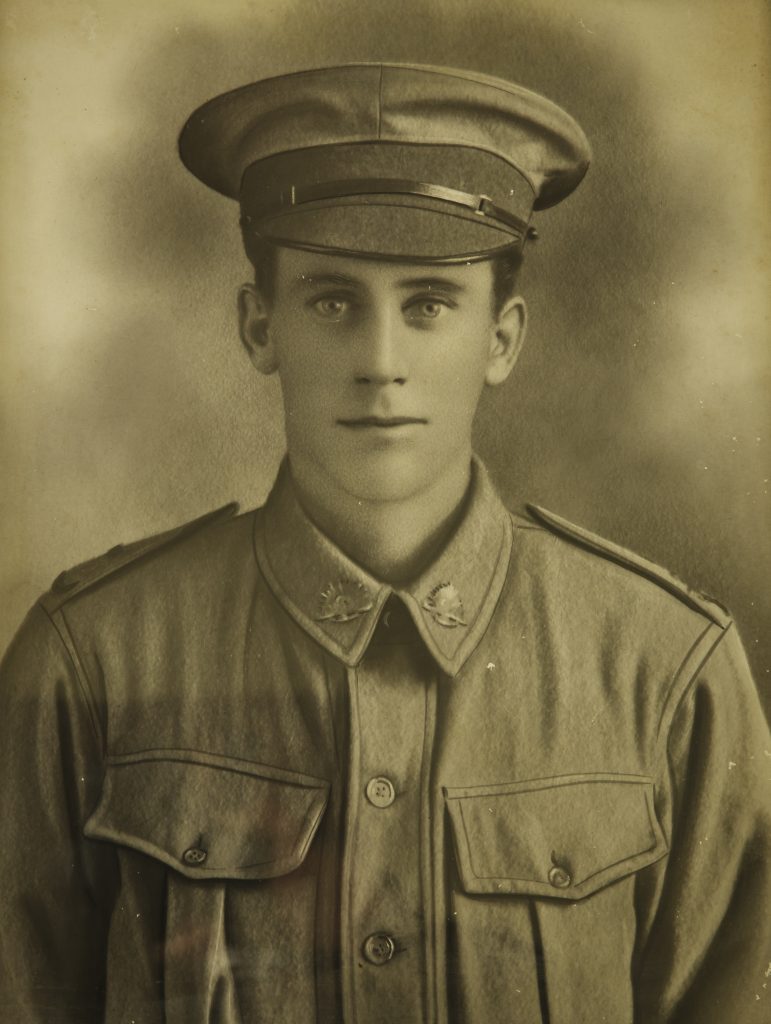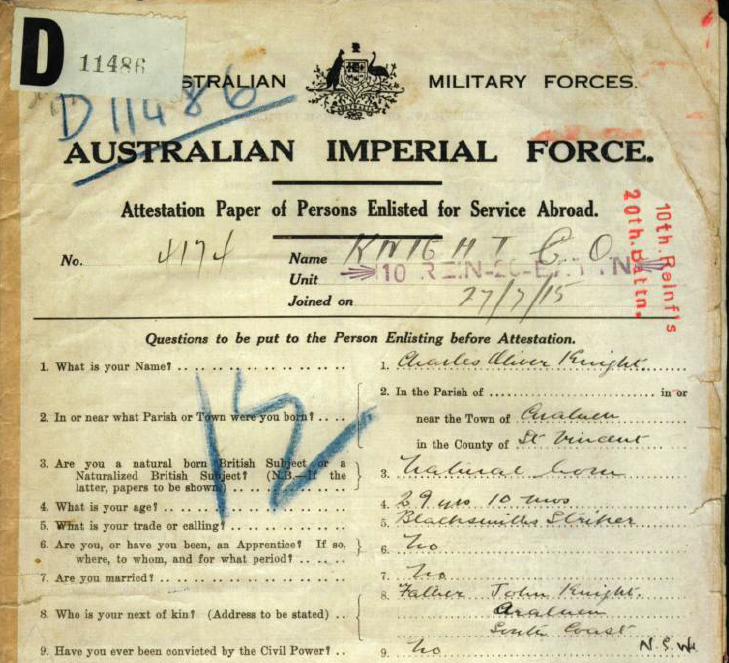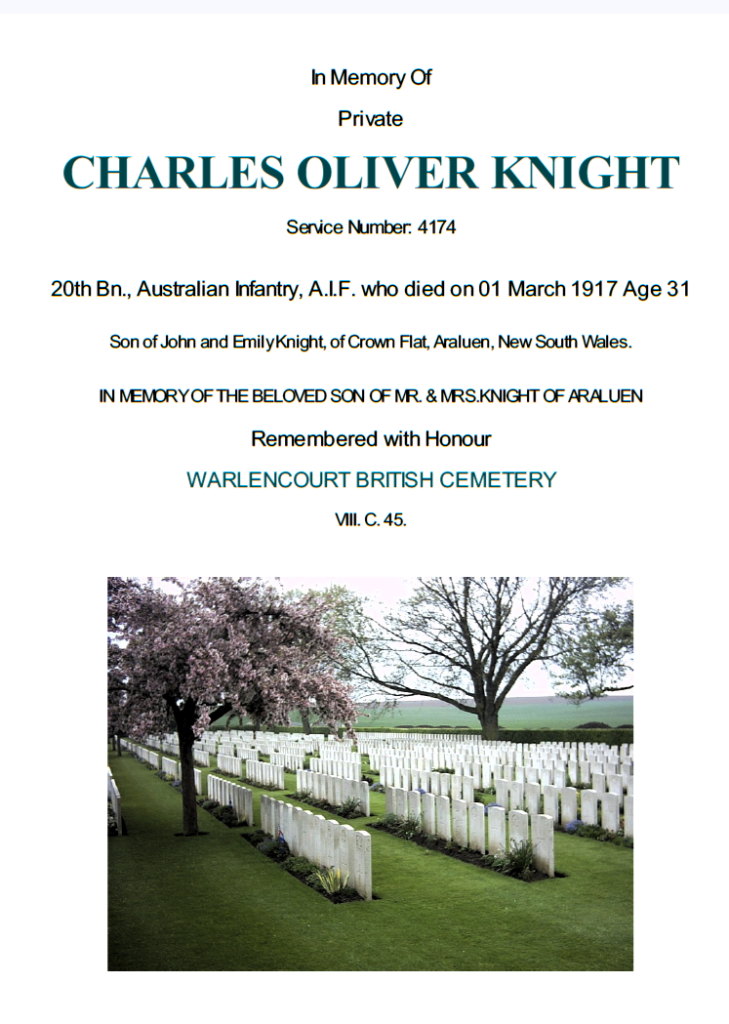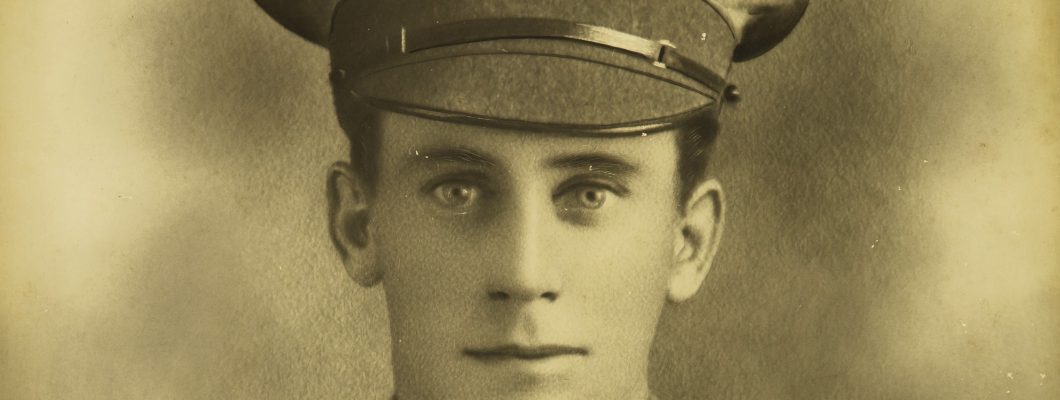
Charles’ occupation and marital status on enlistment was detailed as a Blacksmiths striker, who was single.
- Date of Birth – 5 December 1885, in Araluen1NSW Birth Death and Marriages, https://familyhistory.bdm.nsw.gov.au/ Birth 16504/1886, Knight Charles O, Parents John and Emily, Registered in Braidwood. Accessed 23 March 2024.
- Parents – John and Emily Knight, Crown Flat, Araluen2Commonwealth War Graves, https://www.cwgc.org/find-records/find-war-dead/casualty-details/241581/charles-oliver-knight/ Accessed 23 March 2024.
- Enlisted in the AIF at Holsworthy on 16 October 1915, aged 29 years and 10 months, and embarked from Sydney on board HMAT A67 Orsova on 11 March 19163University of NSW AIF project https://aif.adfa.edu.au/showPerson?pid=167326 Accessed 24 March 2024.
- Regimental Number – 41744National Archives of Australia. https://www.naa.gov.au/. NAA: B2455, Knight, Charles Oliver, Item ID – 7373509, Accessed 23 March 2024.
- Aged at embarkation – 30 years
- Military service – 20th Battalion, 10th Reinforcement. Rank – Private. Served at the Western Front and awarded the British War Medal, and Victory Medal.5Virtual War Memorial Australia, https://vwma.org.au/explore/people/350786. Accessed 23 March 2024.
- Killed in action on 1 March 1917 (aged 31 years)6 Australian War Memorial, https://www.awm.gov.au/collection/R1639882. Accessed 23 March 2024.
- Buried – Warlencourt British Cemetery, France7Find a Grave.com. Panel 91, on a monument at the Australian War Memorial, Canberra. https://www.findagrave.com/memorial/249813508/charles-oliver-knight Accessed 23 March 2024.
Charles Oliver Knight was born at Araluen on 5 December 1885, and was the second son of John William Knight and Emily Shipway. John and Emily had eight children–Sarah, James, Charles, Henry, Robert, Lydia, Alice and Ruby.
In 1896, the Araluen correspondent of the Dispatch as reported in the Goulburn Evening Penny Post8Goulburn Evening Penny Post (NSW : 1881-1940), Tuesday 14 July 1896, p 4. wrote ‘On Monday last James Knight [Charles’ brother] aged 13, son of Mr. John Knight of Crown Flat, met with a peculiar and painful accident. He was engaged drawing water from a well adjoining the house, when he slipped and fell in, a distance of about 20 feet, to the water. Some of his brothers saw him and procured assistance; a rope and bucket were lowered to him, and he was drawn several foot above the water, when the windlass gave way, falling and striking the boy on the head, and inflicting a deep gash. After a while the neighbours succeeded in getting him out. I am pleased to hear that the lad is out of all danger and on a fair way to mend.’

In June 1908, the Braidwood Dispatch and Mining Journal9Braidwood Dispatch and Mining Journal (NSW : 1888-1889; 1895; 1897-1954), Saturday 27 June 1908, p 2. reported ‘Mr. John Knight, winchman on the Crown Flat dredge, had his arm broken on Tuesday night, being hit by the winch. It was at first thought that both were broken. Luckily there was only the one, and the other was bruised. Mr. Knight had the same arm broken before in the same way.’
Charles joined the NSW Government Railways and Tramways as a blacksmith’s striker at the Randwick Tramway Workshops in July 1908 and transferred in the same role to the railway workshops at Eveleigh in October 1912. In October 1915 he enlisted in the AIF at Holsworthy.
Charles embarked from Sydney in March 1916. He was sent, via Egypt, to France where he landed in May. He was treated for scabies in June before joining the 20th Battalion ‘in the field’ on 30 July. Five days later he was wounded in action at Pozières (gunshot wound right arm) and sent to England. He was discharged from hospital on 1 September and classed ‘fully fit’. He enjoyed a fortnight’s leave before returning to camp. He then spent two weeks suffering from mumps. In January 1917 he was sent back to France and re-joined his unit on 19 February 1917.

On 1 March 1917 Charles was killed in action and buried at a map reference SE of Le Sars, 3½ miles SW of Bapaume. After the war his remains were exhumed and re-interred in the Warlencourt New British Cemetery, 2½ miles SW of Bapaume.10Australian War Memorial Honour Roll and notes for the Great Sydney Central Station Honour Board. https://vwma.org.au/explore/people/350786
The Braidwood Dispatch and Mining Journal11Braidwood Dispatch and Mining Journal (NSW : 1888-1889; 1895; 1897-1954), Friday 30 March 1917, p 9. reported in March 1917 ‘Quite a gloom was cast over the Valley on Saturday last [March 1917] when it became known that Cecil Byrne and Charles Knight had lost their lives in recent fighting on the western front. …. A wire, received later on the same day by Mr. and Mrs. J. Knight, of Crown Flat, conveyed the sad news that their son, Charles Knight, had been killed in action. Private Knight enlisted in Sydney, where he had been living for some time, more than a year ago. Much sympathy is felt locally for the parents and relatives of both these young men, who have given the strongest possible proof of a genuine patriotism by laying down their lives for their country.’
The Braidwood Dispatch and Mining Journal12Braidwood Dispatch and Mining Journal (NSW : 1888-1889; 1895; 1897-1954), Friday 27 April 1917, p 9. published ‘MR. and MRS. JOHN KNIGHT and FAMILY, of Araluen, desire to return THANKS to relatives and friends for Cards, Letters of Sympathy, &c., in their sad bereavement on the death of their dear son, Private Charles Oliver Knight.’
